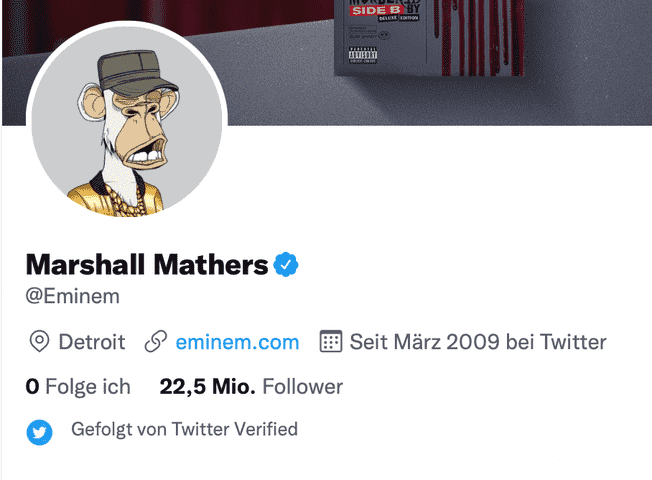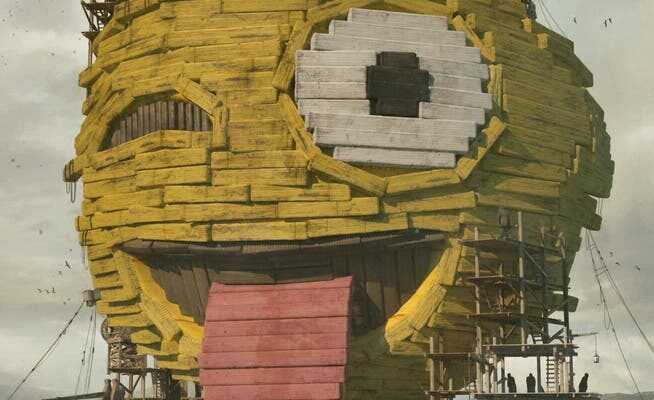For some non-fungible tokens are the future of art, music and asset ownership, for others they are part of a huge valuation bubble. The first NFT expert comments on the value of the digital certificates of authenticity.
One of the digital images that, along with 5000 others, make up the work «Everydays: the First 5000 Days».
Opinions are already divided when it comes to cryptocurrencies such as Bitcoin and Ether, but when it comes to NFT, the gap between advocates and critics is even deeper. Skeptics see digital certificates primarily as the “next crypto bubble”. When the digital artist Beeple raised 69 million dollars with the sale of the work “Everydays: the First 5000 Days” at Christie’s in March 2021, the general public became aware that there was a new art form in the digital space: NFT, Non-Fungible Token.
Twitter NFT descending
An NFT is a certificate of authenticity that records the originator and owner of a digital asset. The blockchain-based token is linked to files such as images and cannot be exchanged – i.e. it is unique. This makes it similar to a work of art in the analogue world. But how do you value these tokens? A few days ago it became apparent that this is also a big question mark for industry experts. The owner of an NFT, which embodies the rights to Twitter founder Jack Dorsey’s first tweet, wanted to auction off the token he bought for $2.9 million. He had a price of up to 50 million in mind. The highest bid so far, on the other hand, is only around $32,000.
just setting up my twttr
— jack⚡️ (@jack) March 21, 2006
Rarity is always a factor that defines asset value. In light of this, Jack Dorsey’s first tweet should be rated higher than the Bored Ape Yacht Club (BAYC) NFT, of which there are several thousand – the most expensive one has sold for over two million dollars to date. To many, the «Apes» may just be simple digital comics, but they are one-of-a-kind items that have 170 unique features of varying degrees of rarity.

The rapper Eminem uses the “EminApe” created especially for him as an avatar on Twitter. The artist paid $460,000 for the NFT.
“These figures give the owner their own identity on the web,” says Caroline Taylor, an art appraiser specializing in NFT. Because of this, musicians, athletes and actors would have acquired the NFT and used them as social media avatars. In addition, the “Apes” have the largest community and the most trade. A separate cryptocurrency was launched, and the owners of BAYC-NFT regularly receive additional services with so-called air drops. But the most important thing is the individuality that you get through the NFT within the “Bored Ape” community, adds the specialist.
The American has been working as a consultant on the art market since 2013, in 2016 she trained as an appraiser and is a member of the US professional organization. Her areas of expertise are post-war art, contemporary art and new art forms. When a client of Taylor bequeathed a Crypto Punks series NFT to a museum, she asked the insurance company to do an appraisal. Taylor developed a paper with ten rating factors and based on that submitted a rating to Lloyd’s of London who insured the artwork on that basis.
Which factors count – and to what extent?
However, Taylor does not disclose the ten evaluation factors and their characteristics – they are proprietary and the business basis of her company Appraisal Bureau. Just this much: Among other things, it is crucial on which blockchain the NFT was “embossed” and what market value it has. In addition: what price comparable works have and how the token can be used. When asked if her NFT Valuation Policy Paper would become the industry standard if Lloyd’s of London used it, Taylor laughed: “It’s an industry standard in that it’s the only valuation method up to now.”
NFTs serviced by Taylor are re-evaluated daily based on these ten points, and the value is reported to the insurance company once a month. Insurance companies would be very interested in having a standardized valuation model, as numerous museums and collectors would like to insure their digital works of art. The market for appraisers for traditional art is very deep. For good reason, the replacement costs are often significantly higher than the fair value. “At NFT we have no experience here, the sector is still in its infancy,” says Taylor.
Nine parameters for evaluation
In a specialist article in the crypto magazine Cointelegraph, the authors list nine factors that determine the value of an NFT. We start with the already mentioned “rarity”: one-off pieces by well-known artists are the rarest. Then comes “utility”: An NFT that embodies tokenized real estate or precious metal has a high utility. “Targetability” is another factor: tokens that embody and secure value in the real world have high tangibility. “Interoperability” also determines the NFT value: if the token can be used in multiple applications, such as an NFT weapon in multiple video games, that makes it valuable.
“Social recognition” can also add value: if a large community uses the same tokens or if an NFT has become known as a profile picture of a star, the value increases. Another factor is the “owner history”: Whether a famous person previously owned the NFT and what prices were paid can be decisive for the value. As with any asset, “liquidity” is key: if an NFT is actively traded, higher prices can be achieved. The level of “speculation” is also a value factor: which NFTs are hip and trending? The value of “Crypto Kitty #18” increased by a factor of 28 in three days in December 2017. As a final factor, the magazine cites “continuous change”: the rise of new phenomena and possible applications such as the Metaverse are constantly changing the value of NFT.
What makes NFTs so valuable? And what are NFTs anyway?!
NFT become the commons
The non-exchangeable tokens are available in several forms. In addition to digital art, there are collectible tokens that can be compared to postage stamps or panini images. These NFTs are spreading across video games and the Metaverse. There are now also tokens that embody ownership of a property in Decentraland. Decentraland is a virtual world in the metaverse. According to Taylor, parameters from “art” NFT are used to value such NFTs, but factors from traditional real estate valuations are also added. Financial products from the Defi (Decentralized Finance) are also mapped to NFT.
Different relationships exist between an NFT and the tokenized asset. A token that embodies ownership of a valuable wine bottle does not match the value of the bottle, but only embodies the value required to prove ownership if, for example, the token is lost. If the wine bottle is destroyed, the token loses all value in return. “One day, NFT will replace PDF as a secure format, and by no means all of them will have to be evaluated,” says the expert.
It takes nerve and crypto knowledge
“In contrast to Bitcoin, which embodies a bearer value, an NFT as a unique piece has an intrinsic value,” says the art expert. It is estimated that the NFT market is now valued at over $40 billion. Taylor also admits that there is a lot of “air” and “hype”. The specialist considers the NFT of the Bored Apes Yacht Club to be the most stable value. They have a high level of acceptance in a large community and are also actively traded. If you buy NFT just to gain recognition, you can make a lot of money, but you can also lose a lot.
A factor slowing down the growth of the NFT market is a lack of knowledge. Some basic knowledge about the blockchain, wallets, etc. is required before one can move safely in the area. Taylor advises that if you’re interested, buy a $10 or $20 NFT and use it to explore the new world. “NFT technology is here to stay,” says the expert. Web 2, which brought us interactivity, is established. Now the IT industry is working on Web 3, on which one moves as a digital personality in the decentralized network in different “worlds”, for example in the metaverse.
The collectors of NFT basically have a high need for information. Because the NFT is based on a blockchain, the value is constantly changing and the need for external evaluation is much higher than traditional art. However, Taylor also notes a keen interest in the new technology from collectors of traditional art, which she knows from her previous work. Artists from the traditional field – photographers, painters, etc. – discovered the possibilities of the new technology for themselves. Such is the contemporary artist Tom Sachs from New York, who became known with mixed media sculptures. Sachs is now creating NFTs that embody parts of a rocket. Once you have all the parts together, the rocket is «built».
